北湖区 廖亚娟 unit 6 A1-20
- 格式:ppt
- 大小:8.76 MB
- 文档页数:28
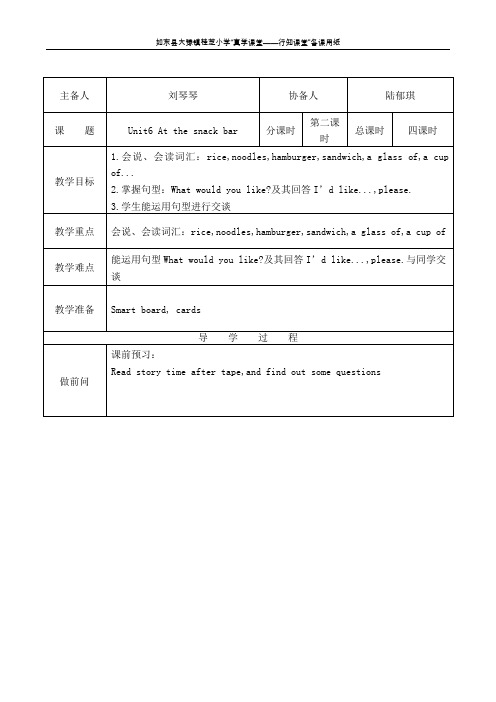
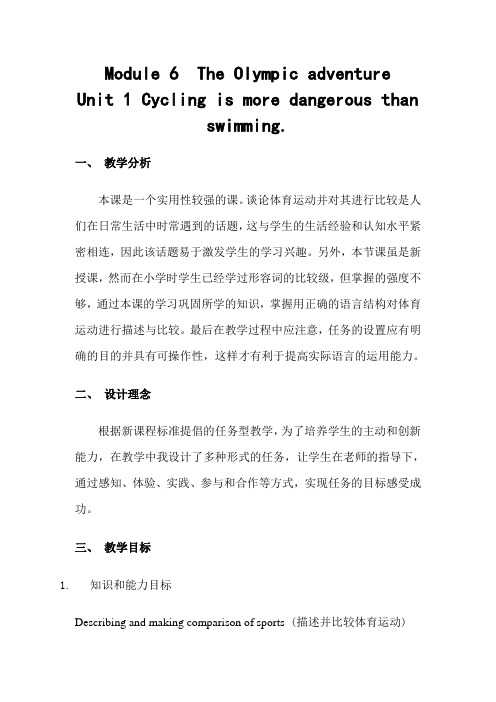
Module 6 The Olympic adventure Unit 1 Cycling is more dangerous thanswimming.一、教学分析本课是一个实用性较强的课。
谈论体育运动并对其进行比较是人们在日常生活中时常遇到的话题,这与学生的生活经验和认知水平紧密相连,因此该话题易于激发学生的学习兴趣。
另外,本节课虽是新授课,然而在小学时学生已经学过形容词的比较级,但掌握的强度不够,通过本课的学习巩固所学的知识,掌握用正确的语言结构对体育运动进行描述与比较。
最后在教学过程中应注意,任务的设置应有明确的目的并具有可操作性,这样才有利于提高实际语言的运用能力。
二、设计理念根据新课程标准提倡的任务型教学,为了培养学生的主动和创新能力,在教学中我设计了多种形式的任务,让学生在老师的指导下,通过感知、体验、实践、参与和合作等方式,实现任务的目标感受成功。
三、教学目标1.知识和能力目标Describing and making comparison of sports (描述并比较体育运动)1)Key vocabulary:gymnastics, ski, more, dangerous, safe, popular, unpopular, exciting, boring, relaxing, tiring, be good at2)Target language: Cycling is tiring.Cycling is more dangerous than swimming. 2.过程和方法目标1) 谈论学生感兴趣的话题,指导学生学习有关运动特征的单词、运动比较的表达及语法知识点“形容词的比较级”。
2) 学生完成教材和老师设置的各项任务,并使用这一课时的目标语言获取与分享信息,自由谈论喜爱的运动并进行比较。
3. 情感态度和价值观目标1) 培养学生养成爱好体育运动的习惯2) 体育运动是各国人们团结友爱的一个纽带四、教学重难点比较级结构:1) 主语(sb / sth)+ be +形容词比较级 + than +…2) The comparatives with “–er/ier” or “more”五、教学方法1) Task-based teaching approach2) The cognitive approach3) The oral approach4) The natural approach六、教学手段Multi-media, computer, projector, flash pictures, body language, listening, practice, chart, pattern-drills, question-answer drills.七、教学过程Step 1: Lead-inT: Boys and girls! Do you like sports?Ss: Yes!T: What’s your favourite sport?S1: Basketball.S2: Table tennis.S3: ……Step2: A test before the classStep 3: Learning Tasks1. Taking about Olympic sports2. Describing and making Comparison of sportsStep 4: Rivision and listening(听力训练)1. Show the pictures. Let the students say the words of Olympic sports.2. Pay attention to two new sports: gymnastics, skiing3. Show the pictures of six kinds of sports4. Activity1: Listen and number the sports5. Check the answers评价Step 5: Vocabulary1. Activity2: Match the sentences with the pictures (评价)2. Focus on six pairs of antonyms: popular, unpopular, exciting, boring,relaxing, tiring, difficult, easy, cheap, expensive, dangerous, safe3. Activity3: Match the words in Box1 with the opposite words in Box24. Check the answers5. Play the tape and let students repeat the sentences.Step 6: Listening and Reading (对话处理)1. Play the tape through for the students to answer the question:How many people have you heard? And who are they? What’s Daming’s favourite sport?2. Check the answers with the whole class3. Read the conversation in pairs and then find out the answers of the questions.4. Check the answers and then read the dialogue again loudly.5. Pay attention to the language points and the structure of thecomparative degree6. ExercisesStep7. 读后学:精讲点拨1.Students learn in groups first2.Teacher stresses and writes down the important pointsBe good at love sb/ sth love doing sth be popular with sb比较级:A + be + more +adj. + than + B.Cycling is more dangerous than swimming.3. 学生活动:practice the comparative degree with the sports and talkabout their favourite sport.Work in pairs. Talk about sports.1). Read out the example2). Pair the students to make similar conversations. Stress that it shouldbe what they think3). Ask several pairs to say one or more of their conversations to the class4. Listen again and finish activity5Step 8: SummaryGive the Ss a chance to sum up what have learned in this class. (Ss can talk about it freely.) Then teacher makes a brief sum-up.1. Key vocabulary and target language2. The structure of the comparative degree3. Beijing2008 Olympic Games----- One Word, One DreamStep9 当堂达标:1.Students finish individually.2.Check the answers.Step 10: Homework (课后提升)1. Read the conversation as fluently as possible and remember theimportant points.2. Finish the exercise on page108 1&23.Write a short composition: “My favourite Olympic sport”. Why do youlike it?About 50 words.3.Preview unit 2。
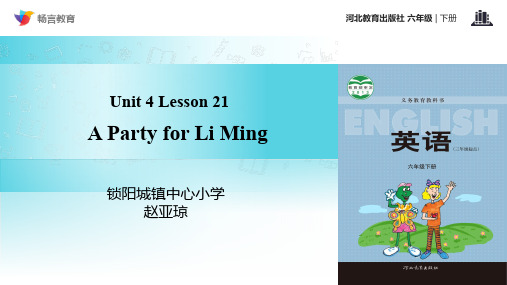
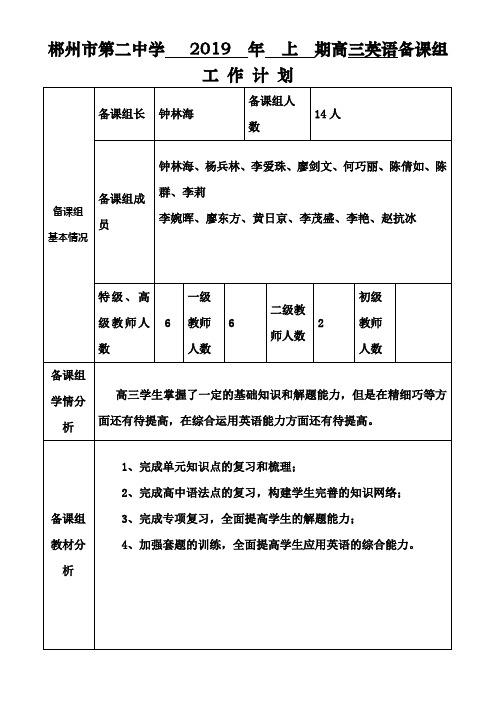
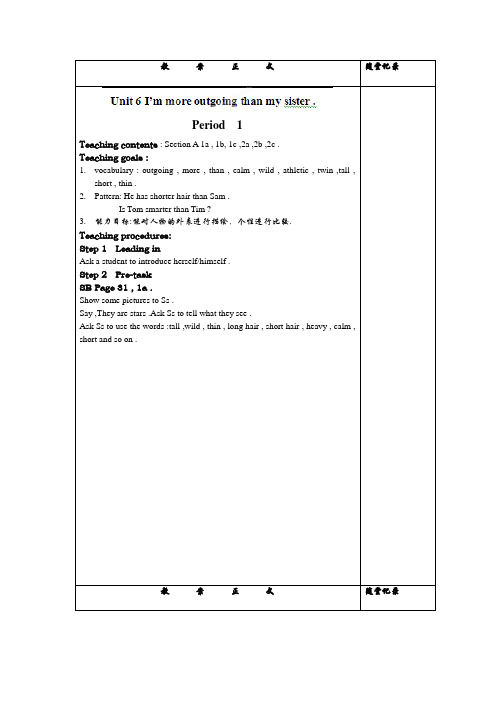
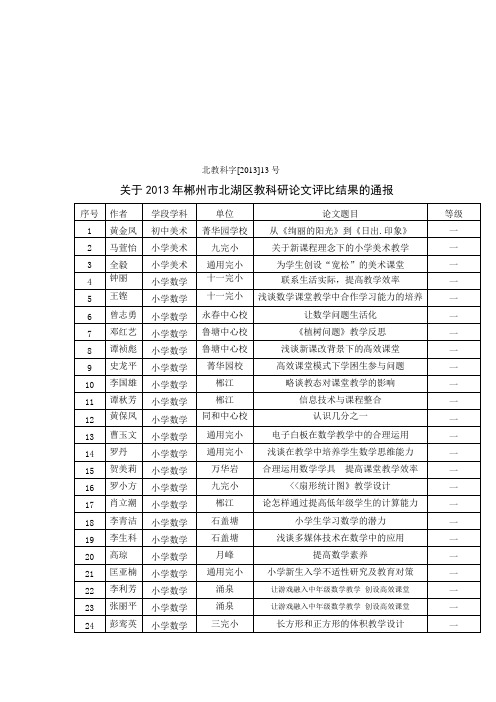
Unit 2 My name’s Gina.Period 5 Section B 3a-Self Check【课型】读写课学习目标1.学会介绍家庭成员。
2.熟练运用以下句型介绍家庭成员:This/That is ...These/Those are ...Who’s ...?3.学会用以下句型了解、询问他人Who’re ...?Is this/that ...?Are these/those ...4.熟练掌握并运用本单元所学词汇进行交际活动。
学习过程【自主学习】分别写出本单元中男性家庭成员、女性家庭成员的英语单词。
Male:father,Female:mother,【师生互动】[新课导入]1.Daily greetings2.Revision:Are you Helen?Is she Helen?Is he Mike?3.Play a guessing game(1)Draw a picture on the blackboard as a model and guess who she/he is,using the sentence structures:—Is she your mother?—No,she isn’t.—Is she your aunt?—Yes,she is.(2)Draw some people on the blackboard.And then guess who they are.4.Talk about your photosShow a picture of a family and introduce the people as a model.Then repeat.[新知学习]Work on 3aplete the passage with the words in the box.Open your books to Page 12.Look at 3a.Please read them aloud.What does “parents” mean?Is Cindy a boy’s name?2.Read the passage.Now please answer the questions.Is Paul a boy or a girl?Who are John and Bob?Is Cindy Paul’s sister?3.Draw a picture of Paul’s family in the box on the right.4.Show their pictures and introduce the people to the class.[新知呈现]●课堂活动一1.Present a picture of a family.Then introduce the people in the picture.2.Practice talking about family photos in pairs.3.Write down what you say.4.Read what you have written to your partners.●课堂活动二Self Check1.T:Look at Self Check,activity 1. In English,some words are for males and some are for females.But some words are not only for males but also for females,such as parents.Now please group the words for family members you have learned.2.Check the answers.3.Get students to complete the conversation in activity 2.(1)Teacher:Please look at the conversation in activity 2.It’s not complete.You can complete it first.(While students are writing,move around to have a look at what they write and offer some help if necessary.)(2)Ask a pair to read their conversation and others check if they are right.(3)Get students to practice reading the conversation.●课堂活动三Summarize1.Learn to read,write and use the words:mother/mom father/dad parents grandfather/grandpa grandmother/grandma grandparents uncle aunt son daughter cousin brother sister friend this that these those she he picture photo2.Learn to read,write and use the sentences:(1)单数/复数This is my friend.These are my friends.That is my brother.Those are my brothers.(2)询问身份—Is she your aunt?—Yes,she is./No,she isn’t.—Is he your uncle?—Yes,he is./No,he isn’t.—Is this/that your sister?—Yes,it is./No,it isn’t.Are these/those your parents?—Who’s he?—He’s my brother.—Who’re they?—They are my grandparents.(3)利用family tree弄清家庭成员之间的关系。
I. Teaching article(课题): Unit 6II. Teaching aims and demands(教学目的和要求): Talk about personal traits.Compare people.Is that Sam?No, that’s Tom. He has shorter hair than Sam.He’s calmer than Sam.III. Teaching importance and difficulty(教学重难点): Comparative with –er, -ier.More and both.IV. Teaching ways(教学方法):Revision, Learning, Practice and Reading. V. Teaching tools(教学工具):Tape-recorder and Lattern.V. Teaching time(教学时间):Six periodsVI. Teaching procedure(教学过程):No. 31 The first periodI. Teaching Aims and Demands1. Knowledge ObjectsKey vocabulary.Target language.Oral Practice.2. Ability ObjectsLearning skill.Speaking skill.Communicative competence.3. Moral ObjectLearn to play a musical instrument..II. Teaching Importance and DifficultyIs that Sam?No, that’s Tom. He has shorter hair than Sam.And He’s calmer than Sam.Is that Tina?No, it isn’t. It’s Tina. Tara’s shorter than Tina.III. Teaching MethodsListening and speaking methods.Communicative approach.IV. Teaching AidsA tape recorder.A projector.Some objects.V. Teaching ProceduresStep I Greet the class as usual and check the homework.Step IIMake a simple drawing of a boy and a girl on the blackboard.Judy is tall.Judy is taller than Bobby.Then bring out two rules of different length. Say:This is ruler. It’s Bobby’s ruler.(longer)This is Judy’s ruler.(long)Bobby’s ruler is longer than Judy’s.Step IIIShow some new words on the blackboard.Read the new words to students and ask them to repeat.Step IV 1aAsk students to do this activity individually. Then check and answers. Tall—short long hair—short hairthin—heavy calm—wildStep V 1bFirst tell students what the twins are. Twins are children born at the same time to the same parents, but not always.Step VI 1c PairworkAsk two students to read the sample conversation to the class.A: Is that Tara?B: No, it isn’t. It’s Tina. Tara’s shorter than Tina..Then have students work with a partner.Make conversation work with a partner.Step VII Pronunciation NoteWrite one of the example sentences from the picture on the board circle the word than say. When we say the word than, we say it quickly. You don’t hear very much of the sound.Step VIII Summary and HomeworkToday we’ve leant the twins are having a concert. We’ve leant how to compare people. After class, give more practice, comparing your school things. Next class I’ll ask some of you to say your conversations OK? Now, class is over? See you!Step IX Blackboard DesignUnit 6 I’m more outgoing than my sisterDraw two people on the blackboard.One is Judy. The other is Bobby.Judy is taller than Bobby.Bobby is shorter than Judy.No. 32 The second periodI. Teaching Aims and Demands1. Knowledge ObjectsKey vocabulary.Target language.Oral Practice.Grammar Focus.2. Ability ObjectsLearning skill.Writing skill.Communicative competence.3. Moral ObjectHandsome is that handsome does.II. Teaching Importance and DifficultyOral practice.Grammar Focus.III. Teaching MethodsListening and writing methods.Communicative approach.Pairwork.IV. Teaching AidsA tape recorder.A projector.V. Teaching ProceduresStep I Greet the class as usual and check the homework.Step II 2aRead the words in the box to students.Funny 有趣的serious 严肃的Outgoing (性格)外向的quiet 安静的Tell students smart and athletic are new words. Explain the new words and tell students what they mean.Step III 2bAsk students to look at the boxes with the headings. Tina is …, Tara is …Listen to the recording again. This time write how Tina and Tara are different. Pleasewrite words in the boxes.Step IV 2c PairworkLet students look at the chart in Activity 2c. Ask two students to read it. Tell students it means Sam is taller than Tom.Have students know they will talk about Sam and Tom in this activity.Student A: Is Tom more intellectual than Sam?Student B: (Look at the answer chart on page 97) No, Sam is smarter than Tom? Step VI Grammar FocusReview the grammar box. Ask a student to read the sentences to the class.Write the word funny on the board. Circle the letter y and say, when a word ends y, the y changes to an I when you add –er. For example, funny – funnier.Step VII Show some dialogue on the blackboardConversation 1:A: Is that Mary?B: No, it isn’t. It’s Peter. Peter is more careful than Mary.A: Yes, Mary is more careless than Peter.Conversation 2:A: Is it Zoe?B: No, it is Wendy. Wendy is shorter than Zoe.Conversation 3:A: Is it Vera?B: No, it’s not. It’s Mary. Mary is thinner than Vera.Step VIII Summary and HomeworkToday we’ve leant some words and learnt how to compare people. I hope you can study harder than ever. You can learn more knowledge and make more progress. After class, read the key vocabulary and learn them by heart.Step IX Blackboard DesignUnit 6 I’m more outgoing than my sisterFunny, funnierMore athletic thanMore intellectual thanMore serious thanNo. 33 The third periodI. Teaching Aims and Demands1. Knowledge ObjectsReading material.Target language.Listening, speaking and writing practice.2. Ability ObjectsLearning and speaking skills.Reading and writing skills.Communicative competence.3. Moral ObjectTo be a brave and hardworking man.II. Teaching Importance and Difficulty Listening, speaking and writing practice.My friend is the same as me. We are both quiet. Do you look the same?No, I’m a little taller than he r.III. Teaching MethodsListening, speaking and writing practice. Reading and writing methods. Communicative approach.IV. Teaching AidsA projector.Some piece of paper.A paper bag.V. Teaching ProceduresStep I Greet the class as usual and check the homework.Step II 3aThere’s a letter in this activity. Read this letter to students. Answer any questions students nay ask. Then show the five sentences on the blackboard.1. Liu Li has more than one sister.2. There are some similarities between Liu Li and Liu Ying.3. Liu Ying is not as good at sport as her sister.4. Liu Ying talks more than Liu Li.5. Both girls go to lots of parties.Step III Grammar NoteWrite these sentences on the blackboard:We are both tall.They are both boys.We both have short hair.They both go to this school.Circle the word both in the four sentences. Ask students: Does the word both come before or after the word are?Step IV 3b PairworkFirst ask two students to read the sample conversation in the speech bubble.Then tell students to work with a partner. Talk about how you are different from a friend of family member.Step VI The Same and DifferentT: Do you find your partner?Ss: Yeah.T: OK. Now I’ll tell you how to do the game. You can ask and answer the same questions as in Activity 3b. Please remember you have three minutes to write down the things that are the different and same between your partner.Step VII An Optional ActivityStudents can do a similar activity using information about family members. They can list the ways they are the same as and different from various members of their families. Then they can tell the class about these differences and similarities.Step VIII Summary and HomeworkToday we’ve read and article and known the same and difference between the twins—Liu Ying and Liu Li. And we’ve done a game. We’ve learnt to say the same and difference between you and your partner.New homework:(1) Read the letter again.(2) Finish off the exercises of workbook.Step IX Blackboard DesignUnit 6 I’m more outgoing than my sisterWe are both tall.They are both boys.We both have short hair.They both go to the school.No. 34 The fourth periodI. Teaching Aims and Demands1. Knowledge ObjectsKey vocabulary.Target language.Oral practice.Listening and writing practice.2. Ability ObjectsLearning skill.Writing skill.Communicative competence.3. Moral ObjectA friend in need is a friend indeed.Wish you to find your real friends.II. Teaching Importance and DifficultyOral practice.Listening and writing practice.III. Teaching MethodsListening and writing methods.Communicative approach.Groupwork.Pairwork.IV. Teaching AidsA projector.A tape recorder.V. Teaching ProceduresStep I Greet the class as usual and check the homework.Step IIShow the new words on the blackboard.Read the new words to students and ask them to repeat.Step III Section B 1aT: All of you have good friends, right?Ss: Yeah.T: Well, can you tell me the same and difference between you and your friends? Sa: He is quieter than me.Sb: We are both tall.Sc: Her hair is longer than mine.T: Great! And what do you think the most important things are to be your friend? Now, please look at the blackboard. I’ll show descriptions on the blackboard.Step IV 16 GroupworkIn this activity students have to work with a group. Ask students to make their own statements about friends using the phrases 1a.Step V An activity Who is it?Ask students to work in small groups. Each and writes down as many sentences as they can to describe him or her.Step VI 2aIn this activity first ask students to look at the names and the first column of the table.Tell students they will hear an interviewer talking to Holly and Maria. They are talking about what they like about their best friends.Step VII 2bLet students look at the rest of the chart. Read the heading at the top of each column.The same as best friend.Different from best friend.Tell students we’ll listen again. Ask students to fill in the chart. How are Holly and Maria the same as and different from their best friends?Step VIII Homework and SummaryToday we’ve recycled some key vocabulary and learnt some new words. And we’ve learnt to talk about our best friends.After class write down five statements about what is important in a best friend. Please remember you can write a false statement among the five statements. Next class we’ll do a game.Step IX Blackboard DesignUnit 6 I’m more outgoing than my sisterA good friend …Has cool clothesIs popular in schoolLikes to do the same things as meIs good at sportIs good at school workMakes me laughNo. 35 The fifth periodI. Teaching Aims and Demands1. Knowledge ObjectsKey vocabulary.Reading passage.Oral practice.Reading and writing practice.2. Ability ObjectsReading skill.Writing skill.Communicative competence.3. Moral ObjectTake an activity part in all kinds of social activities.Get a chance to train your integrating skills.II. Teaching Importance and DifficultyOral practice.Writing and speaking practiceIII. Teaching MethodsListening and writing methods.Reading and writing methods.Communicative approach.Pairwork.IV. Teaching AidsA projector.Pieces of paper on which students write the five statements.V. Teaching ProceduresStep I Greet the class as usual and check the homework.Step IIShow the new words on the blackboard.Read the new words to students and ask them to repeat.Step III 3aIn this activity first read the article to students. Then answer any questions students any ask. For example,S: What’s view?T: It’s what you think about something.It’s how you feel about something.Step IV 3bFirst let students look at the chart in Activity 2a on page 38. Then ask students to write their own sentences about Holly’s friend and some sentences about Maria’s friend.Step V 3cIn this activity first ask students to say some of the words and phrases from this unit they can use. For example,Tall, short, thin, heavyAthletic, intellectual, shyOutgoing, seriousStep VI 2aIn this activity first ask students to look at the names and the first column of the table.Tell students they will hear an interviewer talking to Holly and Maria. They are talkingabout what they like about their best friends.Step VII Pairwork Find Someone for the Job!Focus students on the job ad. Ask students if they know the word—abacus. If they don’t know, explain it to them.Abacus—a frame with balls that was used to do arithmetic, long before calculators. Step VIII Homework and SummaryToday we’ve reviewed the key vocabulary in this unit by reading practice.. And we’ve learnt to write about our best friends.Now homework, write down the words you underlined in Activity 3a in your exercise book.Step IX Blackboard DesignUnit 6 I’m more outgoing than my sisterSentences students write:The name of a student who should get the jobX X XReasons:No. 36 The sixth periodI. Teaching Aims and Demands1. Knowledge ObjectsReviewing the key vocabulary in this unit.Writing practice.Just for fun.2. Ability ObjectsSelf check skill.Writing skill.3. Moral ObjectStudy hard and make great progress.II. Teaching Importance and DifficultyWriting practice.Reviewing the key vocabularyQuiet, funny, outgoingKind, athleticIII. Teaching MethodsSelf check method.Writing method.Communicative method.IV. Teaching AidsA projector.A tape recorder.V. Teaching ProceduresStep I Greet the class as usual and check the homework.Step II Self Check 1After students finish writing their sentences, w rite a number of student’s answers on the blackboard.(1) My friend likes sports. She’s very athletic.(2) Paul is never quiet! He can’t stop talking.(3) Mr. Wang is a kind man. He always helps others.(4) Mary is a funny girl. She always makes me laugh.(5) Jane isn’t very outgoing. She likes to stay at home and rest.Step III 2First ask different students to read the questions on the left. Students read.Are you taller now?Are you more intellectual?Are you more popular?Are you a better student?Then ask students to think of themselves two years ago. How are they different now? Step IV Just for Fun!Ask two students to read the dialogue to the class. Two students read.A: I think I see the twins. Is that Juva?B: No, that’s Jala. Jala has curlier hair than Juva.A: And Juva is taller than Java.Write the words curly—curlier on the blackboard. Explain the words curly to students or draw a simple picture what curlier hair means.Step V WorkbookRead this article about Ali and Ahmet. Then answer the questionsStep VI SummaryThis class we’ve reviewed the key vocabulary of the unit. And we’ve learnt how to compare our/themselves between now and two years ago. I hope you can make great progress.Step VIII HomeworkFinish off the exercises of the WorkbookStep IX Blackboard DesignUnit 6 I’m more outgoing than my sisterCurlyCurlierCurly hairVII. Teaching conclusion(教学后记):。
Unit 3 B ack to the pastReading Lost Civilizations衡山四中廖亚娟一学情分析:The class is given to Senior One students who have mastered a certain amountof English words and phrases as well as acquired some useful reading strategies , such as skimming for main idea and scanning for specific information. However, they still have difficulty in dealing with some problems concerned with guessing new words, inferring and underrstanding the tone of the passage.二教学设计1)Teaching aims:2)To talk about lost civilizations1)To help the students develop the ability of reading diary entries.Important and difficult points:3)The way of reading diary entries.4)To enable the students to improve their reading abilities through some practice and to arouse their sense of protecting civilizations.Teaching procedures:Step1Lead-in1.Start the class by talking about something that students are familiar with. Choose a topic about ancient civilizations in China to arouse their interest. Ask students the following questions;In the past thousands of years,people have built many magnificent structures around the world.China has a long histroy. Can you name some buildings that could represent ancient civilization in China? (the Great Wall, the Temple of Heaven,the Summer Palace, the Potala Palace)Have you ever been to these places?2.Ask students to name as many lost civilizatiopns as they can.(Pyramids in Egypt the Statue of Zeus the Taj Mahal the city of Pompeii )3.Show some pictures of Pompeii and Loulan. Ask them the questions to arouse them interest.Are you curious about what the two cities look in the past?Can you guess why people disappeared from the two cities?What happened to them?Step2 Reading comprehension.1.Have students have a quick look at the text and find the answers to questions in Part A.2.Let students read the Reading strategy.1.When you are reading diary entries recording someone’s travels, you should look for:⑴Dates and place names⑵Facts and historical information⑶Personal feelings and opinions2.Find out the facts and historical information about the two cities.Pompeiitime event in the 8th centuryin 89 BCon 24th Aug. AD 79in 1860Loulan 2000 years agofrom AD 200 to AD 500 100 years ago3.Have students read the passages again and finish C1 C2 and D2 and EStep 3Homework.1. Read the passage carefully and review the new words and phrases.2. Make a summary of the text.三教学后记1) 课件图片吸引人,学生很感兴趣。